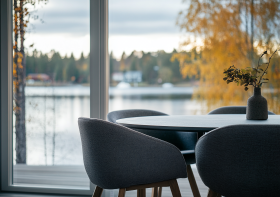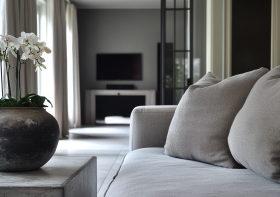The Art of Mixing Materials to Enrich Your Home’s Aesthetics

In the realm of interior design, texture plays a pivotal role in creating environments that are visually interesting and tactilely inviting. Textural contrasts, in particular, can enhance the depth and dynamism of a space, providing sensory experiences that elevate the overall aesthetic. This blog post explores the art of mixing materials to create rich, tactile environments that captivate and comfort.
Understanding Texture in Interior Design
Texture in interior design refers to the surface quality of a material, which can be seen and felt. Textures can be categorized broadly into two types: visual textures that contribute to the look but not necessarily the feel of a surface, and actual textures that affect both the appearance and the feel.

Layer Different Textures
One effective way to incorporate texture is through layering. Start with a base texture, such as smooth hardwood floors, and layer with a plush rug for contrast. Soft furnishings like velvet sofas or silk cushions can be paired with rougher textures such as jute throws or rattan chairs to create a balance that appeals to the senses. The key is to ensure that the textures vary enough to stand out while maintaining a cohesive color scheme to unify the space.

Incorporate Natural Elements
Bringing elements from nature into your home is a fantastic way to introduce texture. Natural wood, stone, bamboo, and wool all offer unique textures that are not only beautiful but also help to create a calming, earthy environment. For example, a granite countertop can be paired with wooden cabinets for a kitchen that feels both luxurious and welcoming. Similarly, a leather armchair next to a soft linen curtain adds a sophisticated touch to a living room.

Play with Wall Treatments
Walls offer a large canvas for textural interplay. Beyond traditional paint, consider materials like textured wallpaper, stone cladding, or shiplap to add depth to your rooms. These materials can create a focal point in the room or serve as a subtle background that enhances other decor elements.

Contrast Fabrics and Upholstery
Mixing fabrics is perhaps one of the easiest ways to introduce textural diversity. Combine different upholstery materials such as suede, leather, and fabric on various pieces of furniture. For example, a leather sofa can be livened up with fluffy throw pillows, a chunky knit blanket, and a sleek silk lampshade nearby.

Lighting and Fixtures
Light fixtures made from contrasting materials can also enhance the textural diversity of a space. A sleek, modern metal lamp can stand out against a rustic, wooden coffee table. Glass or crystal chandeliers can make a striking contrast when hung in rooms with exposed brick or concrete elements.

Don’t Forget the Floors and Ceilings
Floors and ceilings are often overlooked in textural design. Consider a rough, exposed beam ceiling above a smooth, polished concrete floor. Or, lay a Persian rug on a sleek marble floor for a touch of warmth and color. These contrasts will draw the eye up and down, making the space more dynamic.

Balance and Cohesion
While it’s exciting to mix and match textures, it’s important to keep balance and cohesion in mind. Ensure that one texture does not overwhelm the others and that all the elements feel intentional and harmonious. A good rule of thumb is to have a mix of two to three different textures in one room.

By mastering the art of textural contrast, you can transform your home into a layered, engaging space that appeals to both the eyes and the touch. This approach not only adds depth to your interiors but also creates a unique, inviting atmosphere for all who enter.
To deepen your understanding of crafting unique and personalized spaces, consider acquiring my book, A Guide to Home Design, available on Amazon. This guide offers a comprehensive exploration of various design principles tailored to distinct environments, providing you with the knowledge and inspiration needed to transform any space. If you want to learn more about the colors in Interior design, buy my book Color theory in interior design from Amazon.




